I would like to generate a bar chart similar to the one shown below. I would like to use rhoas x-axis and power as y-axis. And I have 2 categorical variables m and c. How can I generate a grouped bar with 2 grouping variables?
Any other idea of visualizing will be welcomed.
In this picture they use m as color, rho and c as x axis variables.
> dput(ds2)
structure(list(X = c(105L, 135L, 141L, 165L, 171L, 177L, 201L,
207L, 213L, 231L, 237L, 243L, 249L, 267L, 273L, 279L, 285L, 303L,
309L, 315L, 321L, 465L, 495L, 501L, 525L, 531L, 537L, 561L, 567L,
573L, 591L, 597L, 603L, 609L, 627L, 633L, 639L, 645L, 861L, 891L,
897L, 921L, 927L, 933L, 957L, 963L, 969L, 1287L, 1293L), d_s = c(0.2,
0.2, 0.2, 0.2, 0.2, 0.2, 0.2, 0.2, 0.2, 0.2, 0.2, 0.2, 0.2, 0.2,
0.2, 0.2, 0.2, 0.2, 0.2, 0.2, 0.2, 0.2, 0.2, 0.2, 0.2, 0.2, 0.2,
0.2, 0.2, 0.2, 0.2, 0.2, 0.2, 0.2, 0.2, 0.2, 0.2, 0.2, 0.2, 0.2,
0.2, 0.2, 0.2, 0.2, 0.2, 0.2, 0.2, 0.2, 0.2), m = structure(c(6L,
5L, 6L, 4L, 5L, 6L, 4L, 5L, 6L, 3L, 4L, 5L, 6L, 3L, 4L, 5L, 6L,
3L, 4L, 5L, 6L, 6L, 5L, 6L, 4L, 5L, 6L, 4L, 5L, 6L, 3L, 4L, 5L,
6L, 3L, 4L, 5L, 6L, 6L, 5L, 6L, 4L, 5L, 6L, 4L, 5L, 6L, 5L, 6L
), .Label = c("5", "10", "15", "20", "25", "30"), class = "factor"),
c = structure(c(3L, 4L, 4L, 5L, 5L, 5L, 6L, 6L, 6L, 7L, 7L,
7L, 7L, 8L, 8L, 8L, 8L, 9L, 9L, 9L, 9L, 4L, 5L, 5L, 6L, 6L,
6L, 7L, 7L, 7L, 8L, 8L, 8L, 8L, 9L, 9L, 9L, 9L, 6L, 7L, 7L,
8L, 8L, 8L, 9L, 9L, 9L, 9L, 9L), .Label = c("4", "6", "8",
"10", "12", "14", "16", "18", "20"), class = "factor"), rho = c(0,
0, 0, 0, 0, 0, 0, 0, 0, 0, 0, 0, 0, 0, 0, 0, 0, 0, 0, 0,
0, 0.01, 0.01, 0.01, 0.01, 0.01, 0.01, 0.01, 0.01, 0.01,
0.01, 0.01, 0.01, 0.01, 0.01, 0.01, 0.01, 0.01, 0.03, 0.03,
0.03, 0.03, 0.03, 0.03, 0.03, 0.03, 0.03, 0.05, 0.05), n0 = c(1984L,
1491L, 748L, 1984L, 748L, 529L, 910L, 552L, 437L, 1984L,
647L, 461L, 387L, 1035L, 529L, 409L, 355L, 748L, 461L, 375L,
333L, 3055L, 2018L, 952L, 2647L, 916L, 638L, 1094L, 650L,
512L, 2464L, 751L, 530L, 443L, 1202L, 601L, 462L, 401L, 12390L,
4206L, 1528L, 5721L, 1370L, 909L, 1602L, 890L, 686L, 25498L,
2685L), results = c(TRUE, TRUE, FALSE, TRUE, TRUE, TRUE,
TRUE, TRUE, TRUE, TRUE, FALSE, FALSE, FALSE, TRUE, FALSE,
TRUE, FALSE, TRUE, FALSE, TRUE, TRUE, TRUE, FALSE, FALSE,
FALSE, FALSE, TRUE, TRUE, TRUE, FALSE, FALSE, TRUE, TRUE,
TRUE, FALSE, TRUE, FALSE, TRUE, FALSE, FALSE, TRUE, FALSE,
FALSE, TRUE, TRUE, FALSE, FALSE, FALSE, TRUE), power = c(0.85,
0.87, 0.92, 0.89, 0.89, 0.89, 0.85, 0.89, 0.87, 0.89, 0.94,
0.9, 0.92, 0.88, 0.93, 0.88, 0.92, 0.88, 0.9, 0.86, 0.85,
0.88, 0.9, 0.95, 0.94, 0.9, 0.87, 0.84, 0.89, 0.93, 0.91,
0.86, 0.87, 0.87, 0.91, 0.88, 0.91, 0.89, 0.95, 0.9, 0.89,
0.95, 0.95, 0.87, 0.85, 0.9, 0.91, 0.91, 0.87)), row.names = c(37L,
51L, 55L, 67L, 71L, 75L, 87L, 91L, 95L, 104L, 108L, 112L, 116L,
125L, 129L, 133L, 137L, 147L, 151L, 155L, 159L, 211L, 226L, 230L,
242L, 246L, 250L, 262L, 266L, 270L, 279L, 283L, 287L, 291L, 301L,
305L, 309L, 313L, 390L, 405L, 409L, 421L, 425L, 429L, 441L, 445L,
449L, 563L, 567L), class = "data.frame")

